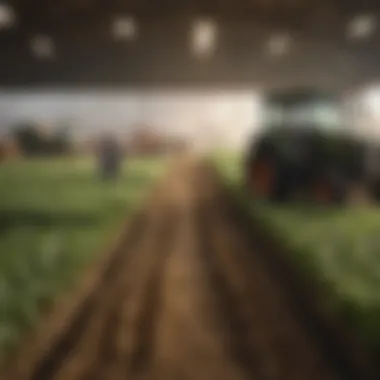Understanding USDA Farm Programs: A Comprehensive Overview


Intro
USDA farm programs encompass a wide array of initiatives aimed at supporting farmers and the agricultural sector. These programs are fundamental to creating sustainable practices and ensuring food security. As agriculture faces various challenges, including fluctuating market prices and climate changes, understanding these programs becomes essential for anyone involved in farming.
Overview of the Topic
Definition and Importance
USDA farm programs refer to a collection of policies implemented by the United States Department of Agriculture. These programs are designed to assist farmers financially and promote the responsible management of land and resources. The importance of these programs cannot be overstated; they help stabilize farming operations, contribute to rural development, and strive to create a balanced agricultural ecosystem.
Current Trends
Recently, there has been a shift towards more sustainable farming practices. Programs now increasingly emphasize conservation and environmental stewardship. There is also an expanding focus on local food systems, connecting farmers directly to consumers. Such trends benefit not only farmers but also enhance community resilience.
Key Techniques and Practices
Step-by-Step Guide
- Research the Available Programs
Understanding what is available is crucial. Websites like the USDA’s official page provide a comprehensive overview of current programs. - Evaluate Eligibility
Each program has its specific eligibility criteria. Reading the guidelines carefully can save time and effort. - Prepare Necessary Documentation
Gather all required paperwork, including financial records and farm management plans. - Complete Application Process
Ensure the application is filled out accurately to avoid delays in processing. - Follow Up and Stay Informed
After submission, regularly check the status of your application and be prepared to provide additional information if needed.
Tools and Equipment Needed
While applying for USDA programs generally does not require specific tools, access to technology (like a computer with internet connection) is essential for completing online applications and effectively managing farm data.
Challenges and Solutions
Common Obstacles
Navigating the complex web of USDA programs can often be daunting. Some farmers struggle with understanding the eligibility requirements, while others may find the application process tedious. Additionally, inadequate access to technology can hinder participation for some rural farmers.
Innovative Solutions
To combat these obstacles, local agricultural organizations can assist farmers. Workshops and information sessions can demystify eligibility criteria and application processes. Furthermore, utilizing online resources, such as social media platforms like Facebook and Reddit, can facilitate discussions among farmers, allowing them to share insights and strategies.
"Staying informed about changes in farm programs is essential for farmers to adapt and thrive."
In summary, USDA farm programs play a crucial role in shaping the agricultural landscape. Understanding their intricacies can empower farmers and stakeholders to make informed decisions, ultimately leading to a more sustainable agricultural future.
Preamble to USDA Farm Programs
USDA Farm Programs play a pivotal role in the agricultural landscape of the United States. They are designed to support farmers through various financial and technical assistance solutions. Understanding these programs is crucial for both current and aspiring farmers, as well as for those interested in agriculture policy and sustainability.
Through these programs, farmers can receive aid that helps them mitigate risks, improve operational efficiency, and adopt sustainable practices. The knowledge about these programs not only empowers farmers but also contributes to the overall food security of the nation. Given the changing climates and economic pressures, these programs become even more relevant.
Historical Background
The origins of USDA Farm Programs can be traced back to the Great Depression in the 1930s. During this challenging time, the government sought methods to stabilize the agricultural market and provide assistance to struggling farmers. The Federal Farm Board, established in 1929, was one of the initial efforts to regulate prices and technological advancements related to farming.
Over the decades, these programs have evolved significantly. Policies have emerged in response to economic fluctuations, natural disasters, and shifts in consumer demand. Today, programs are diversified and aim to address not only traditional farming methods but also modern sustainability challenges. Programs such as the Conservation Reserve Program (CRP) showcase a response to environmental concerns, emphasizing the need to preserve natural resources.
Purpose of the Programs
The primary objective of USDA Farm Programs is multifaceted. First, they aim to stabilize farm income and ensure financial viability for farmers. This aspect is crucial as it provides a safety net for those facing unpredictable market fluctuations or adverse weather conditions.


Furthermore, these programs promote environmental conservation. By encouraging practices that protect water quality, enhance biodiversity, and preserve soil health, the USDA addresses present-day ecological challenges. Programs like the Environmental Quality Incentives Program (EQIP) exemplify efforts to integrate conservation with agricultural productivity.
Finally, the USDA farm programs also strive to promote food security on a national level. By supporting farmers through direct payments and subsidies, the government ensures that food supply remains stable and sufficient for the growing population. This holistic approach to agricultural policy demonstrates its broader significance in ensuring not just farmer profitability but also public welfare.
Types of USDA Farm Programs
Understanding the various types of USDA farm programs is essential, as they serve as the backbone of agricultural support in the United States. Each program is designed with specific goals, benefiting farmers, promoting sustainable agricultural practices, and enhancing food security. The categories of these programs can broadly be divided into conservation programs, commodity support programs, and disaster assistance programs. Each type offers distinct features that cater to different needs within the agricultural sector.
Conservation Programs
Conservation programs play a pivotal role in promoting environmentally sustainable farming practices. They are engineered to help farmers adopt practices that improve environmental health. These programs often facilitate ecosystem restoration and help in preserving natural resources.
Environmental Quality Incentives Program (EQIP)
The Environmental Quality Incentives Program is a key program aimed at encouraging agricultural producers to implement conservation practices. It offers financial and technical assistance to farmers who undertake conservation projects. A notable characteristic of EQIP is its flexibility; it allows farmers to choose the practices that best suit their operations.
EQIP is often favored due to its ability to target localized issues, thus contributing significantly to environmental goals on a community level. The unique feature of this program is its partnership with conservation districts, making it easier for farmers to access support tailored to their specific needs. However, one of the disadvantages can be the complexity of the application process, which can be a barrier for some farmers.
Conservation Reserve Program (CRP)
The Conservation Reserve Program is another important initiative, focusing on removing environmentally sensitive land from agricultural production. It provides annual rental payments to farmers who agree to remove these lands from farming for a specified period. The key characteristic here is the long-term commitment, often spanning ten years or more.
CRP seeks to enhance wildlife habitat and improve water quality by incentivizing the planting of cover crops and other conservation practices. A unique aspect of CRP is its focus on biofuels, encouraging farmers to adopt practices that align with renewable energy goals. However, some critics argue that the program could limit the land available for food production, which poses a challenge in terms of meeting the nation's agricultural demands.
Commodity Support Programs
Commodity support programs are essential for stabilizing farm income and ensuring that farmers can maintain their livelihoods in the face of fluctuating market conditions. These programs include various financial mechanisms designed to safeguard agricultural markets.
Price Support Programs
Price support programs are designed to boost the prices of certain agricultural commodities. By implementing minimum price levels, the USDA can help stabilize income for farmers during low market conditions. The key characteristic of these programs is their ability to intervene directly in the marketplace.
These programs are beneficial because they provide a safety net for farmers, ensuring that they can cover their production costs. However, the potential downside is that these interventions can sometimes distort market signals, leading to overproduction or inefficient resource allocation, which can be problematic in the long term.
Direct and Counter-Cyclical Payments
Direct payments program offers subsidies to farmers regardless of current market prices, providing them with a stable income source. On the other hand, counter-cyclical payments are triggered when market prices drop below a certain threshold. The unique aspect of this dual approach allows for a more nuanced support system.
Direct and counter-cyclical payments are desirable because they provide timely financial relief to farmers when they need it most. Yet, one limitation could be that these payments may not fully offset losses in revenue, depending on the severity of market fluctuations.
Disaster Assistance Programs
Disaster assistance programs are vital in helping farmers recover from unforeseen events such as natural disasters or disease outbreaks. These programs aim to buffer the impact of such disasters on agricultural operations.
Emergency Farm Loans
Emergency farm loans are available to assist farmers in recovering from losses incurred during disasters. These loans provide timely financial assistance, a key characteristic that helps farmers regain stability. The accessibility of these loans makes them a popular option for farmers facing immediate financial distress.
A unique feature of emergency farm loans is their flexibility in use, allowing farmers to cover various expenses. However, borrowing can lead to long-term debt, which poses risks if future income does not rebound.
Livestock Indemnity Program (LIP)
The Livestock Indemnity Program compensates farmers for livestock losses caused by adverse weather or attacks from wildlife. This program offers direct payments based on the number of livestock lost, making it a crucial support mechanism for livestock producers.
The strong point of LIP is its targeted approach to livestock producers, ensuring they receive adequate compensation. Nonetheless, one disadvantage is that the compensation may not always reflect actual market value, hence leaving some livestock owners at a loss.


Ultimately, these types of USDA farm programs demonstrate a comprehensive approach to agricultural support, addressing various facets from conservation to disaster recovery. Understanding their distinct characteristics is crucial for farmers aiming to navigate the available resources effectively.
Eligibility Criteria for USDA Farm Programs
Understanding the eligibility criteria for USDA farm programs is essential for farmers seeking assistance. These criteria determine who can access the various programs offered by the USDA. Without meeting these requirements, farmers may miss opportunities for financial support, risk management, and other beneficial services. Thus, clarity on these criteria ensures that eligible applicants can take full advantage of the tools available to them.
General Eligibility Requirements
General eligibility requirements serve as the foundation for accessing USDA farm programs. These include a range of factors such as agricultural production, ownership of a farm, and citizenship status. Typically, applicants must prove they are engaged in a farming operation, whether as an owner, operator, or renter. In addition, the successful candidates are often required to maintain detailed records demonstrating their farming activities and financial standing. By ensuring applicants fulfill these requirements, the USDA can allocate resources more effectively and support agricultural sustainability.
Specific Program Eligibility
Income Limits
Income limits are a has become a key aspect of program eligibility within USDA farm programs. This aspect ensures that financial assistance is directed to those who truly need it. The USDA sets specific income threshold levels, which vary by programs. The key characteristic of these income limits is their focus on assisting small and medium-sized farms, which often face more significant challenges than larger operations. For example, certain programs may exclude applicants whose income exceeds a percentage of the median income for that area. This approach supports equitable distribution of funds and resources, enabling farmers with lower incomes to receive the help they require for essential operational costs.
However, one unique feature of income limits is how they can sometimes disqualify farmers who might be experiencing seasonal challenges but are not permanently below the income threshold. While this system promotes inclusivity, it may inadvertently exclude niche farmers or those in cyclical industries. Therefore, the balance between providing support and enacting necessary limits can often become a point of discussion among stakeholders.
Farm Size and Type
Farm size and type is another critical element influencing eligibility for specific USDA farm programs. Different programs may target particular types of agricultural production, such as cotton, corn, or organic farming. This means that farmers must assess their operation's alignment with a program's focus. Additionally, the size of the farm can affect eligibility. Larger operations might have different qualification standards compared to smaller farms, which may be better suited for specific assistance.
The key characteristic of these requirements is the emphasis on tailoring support to suit various farming operations. This specificity helps ensure that the assistance provided addresses the unique circumstances of different types of farms. For instance, small family-owned farms often require different resources than large industrial farms, leading to program designs that consider these differences.
In terms of unique features, farm size criteria may utilize a combination of acreage and production output to evaluate eligibility. This method can be both an advantage and a disadvantage, as it allows for tailored support but may also limit resources for farmers who don't fit neatly into the defined parameters. Therefore, understanding these nuances is essential for anyone engaging with USDA farm programs.
Application Process for USDA Farm Programs
The application process for USDA farm programs is a critical component that defines how effectively farmers can access support and resources. Understanding this process is essential as it not only promotes informed participation but also ensures that eligible farmers benefit from the available programs. Effective applications can lead to support for sustainable practices, financial assistance, and much more. This section outlines the necessary steps and considerations for successfully navigating the application process.
How to Apply
Applying for USDA farm programs involves a series of straightforward steps. First, farmers must identify which specific programs align with their needs. Each program has distinct requirements and objectives. The following outlines the general steps involved in the application:
- Research Programs: Familiarize yourself with various USDA farm programs that are relevant to your farming activities. This includes conservation, commodity support, and disaster assistance.
- Check Eligibility: Ensure you meet the eligibility criteria established for the specific program you wish to apply for. This is crucial as ineligible applications are usually rejected.
- Complete the Application Form: Download or request the appropriate application form from the USDA's official website or local office. Fill it out completely and accurately.
- Submit the Application: Send in your completed application form before the deadline. You can submit it in person or through electronic means depending on the program's protocol.
Overall, clarity and attention to detail are vital at each stage of the application process. Failure to follow these steps can delay assistance or result in rejection.
Documentation Required
Documenting your application is equally important. Accurate documentation not only supports your application but also helps in verifying eligibility and assessing needs. Below are the key documents typically required:
- Proof of Identity: A government-issued ID is typically required to establish identity.
- Income Verification: This may include tax returns, profit and loss statements, or other financial records.
- Farm Records: Documentation related to farm size, type, and production history often needs to be submitted.
- Program-Specific Documents: Depending on the program, you may need to provide specific forms or additional documentation.
"Having complete and organized documentation is crucial. It can expedite the application process and improve your chances of approval."
Ensuring that all required documentation is attached and well-organized is essential. Missing documents can cause delays and complicate the process. Each farm situation is unique, so it is advisable to consult with local USDA representatives for specific requirements regarding the programs you are interested in.
Impact of USDA Farm Programs on Agriculture
The impact of USDA Farm Programs on agriculture is profound and multifaceted. These programs are not only essential for supporting farmers but also play a significant role in shaping the agricultural landscape of the United States. Addressing economic stability and environmental health, these initiatives aim to create a sustainable framework for farming practices. They help producers manage risks, ensuring food security while promoting responsible stewardship of resources.
Economic Effects


The economic implications of USDA Farm Programs are far-reaching. These programs provide essential financial support to farmers, which can stabilize their income in uncertain times. For instance, commodity support measures cushion the volatility associated with market fluctuations. The price support programs help maintain stable prices for essential crops, such as corn and wheat.
Moreover, direct payments can empower farmers to invest in their operations. This investment can lead to improvements in productivity, which in turn positively affects local economies. Increased production translates into more jobs in agriculture-related sectors, such as equipment manufacturing and food processing.
The economic ripple effect extends beyond just farmers. When farmers have financial security, they are more likely to participate in local economies, purchasing goods and services from nearby businesses. Thus, the economic effects of these programs contribute significantly to community resilience as well.
Environmental Benefits
The environmental benefits of USDA Farm Programs are substantial and critical in today’s context of climate change. Conservation Programs, such as the Conservation Reserve Program, incentivize farmers to adopt practices that enhance biodiversity and protect natural resources. These initiatives reduce soil erosion and improve water quality by encouraging sustainable land management techniques.
Furthermore, many of these programs promote the adoption of environmentally friendly practices. Farmers are encouraged to implement crop rotation, cover cropping, and reduced tillage. Such practices not only help in preserving soil health but also mitigate the effects of climate change by sequestering carbon.
These efforts present an opportunity for Agriculture to be a part of the solution to environmental challenges, promoting sustainable methods that align economic viability with ecological responsibility.
In summary, USDA Farm Programs serve as a cornerstone of modern agriculture. They provide economic stability for farmers while ensuring that environmental practices are maintained, making them indispensable for a sustainable agricultural future.
Challenges Faced by USDA Farm Programs
USDA farm programs serve as vital instruments for supporting agricultural health and sustainability. However, as essential as they are, these programs encounter significant challenges that can hinder their effectiveness. Understanding these challenges is crucial for stakeholders, including farmers, policymakers, and agronomists, to improve and adapt these programs for better outcomes. This section discusses the primary hurdles that affect USDA farm programs, focusing on funding limitations and the ramifications of policy changes.
Funding Limitations
One of the most pressing challenges faced by USDA farm programs is funding limitations. The success of these initiatives often depends on the availability and allocation of federal funds. When budgets are tight, the programs may receive cuts, impacting the support that farmers rely on. Limited funding can lead to a reduction in the scope of programs, resulting in fewer resources for education, outreach, and assistance.
Farmers are often at the mercy of the federal budget cycle. When funding is inadequate, it can create uncertainty for farmers making critical decisions regarding their operations. For instance, environmental initiatives that require upfront investments may suffer when there's a lack of financial backing. Moreover, limited funding can exacerbate disparities in access to programs. Small-scale farmers may struggle to compete for available resources against larger operations with established networks and better access to information.
"Adequate funding is essential not only for the stability of the programs but also for the long-term sustainability of the agricultural sector as a whole."
Policy Changes and Impacts
The landscape of USDA farm programs is not static; it is subject to shifts in policies that can stem from both federal and state levels. These changes can affect the administration of existing programs, the eligibility criteria, or even the core objectives. Such volatility often creates confusion among target users, leading to hesitation or misalignment in participation.
Changes in policy can come from political pressures, shifts in administration, or evolving societal needs. For instance, increased focus on environmental sustainability may reshape existing programs to prioritize conservation over traditional commodity support. This adaptation, while necessary, can lead to disruptions for farmers who are accustomed to certain programs. They may face difficulties adjusting to new requirements, potentially thwarting their ability to access benefits.
Additionally, rapid policy changes can lead to a lack of continuity in agricultural planning. Farmers need stability to ensure that they can make long-term plans about crop production, investments in technology, or infrastructure improvements. A lack of clear guidance can result in missed opportunities or wasted resources, as farmers may invest in initiatives that are soon altered or eliminated.
Future Directions of USDA Farm Programs
The future of USDA farm programs is pivotal in shaping the landscape of American agriculture. With ongoing challenges posed by climate change, market volatility, and shifting consumer preferences, these programs must evolve. Continuing to support farmers sustainably while ensuring food security remains indispensable. Developing innovative solutions and strengthening resilience in agricultural practices will enable USDA farm programs to adapt successfully to emerging challenges.
Innovations in Agricultural Support
Innovation in agricultural support encompasses a variety of strategies aimed at enhancing productivity while minimizing environmental impact. Technologies such as precision farming and data analytics are becoming essential tools for farmers. These innovations allow for optimized resource use and improved crop yields.
Some critical areas of innovation include:
- Precision Agriculture: Using GPS and other technologies to precisely manage field variability.
- Biotechnology: Developing crops that require fewer inputs or are resistant to pests and diseases.
- Digital Platforms: Offering farmers access to market information, weather forecasts, and financial resources in real-time.
These advancements can significantly impact how farmers manage their operations, leading to increased efficiency and sustainability. The USDA needs to support these innovations by facilitating access to funding and resources, ensuring that farmers of all scales can embrace these technologies.
"Adoption of technology is essential for sustainable agricultural practices. Our future depends on it."
Sustainability and Climate Resilience
Sustainability and climate resilience are central themes in the future of USDA farm programs. As global temperatures rise and extreme weather events become more frequent, American agriculture faces unprecedented challenges. The USDA must prioritize practices that not only sustain current productivity but also protect the environment for future generations.
Key focus areas include:
- Soil Health: Promoting practices like crop rotation and cover cropping to maintain healthy soil.
- Water Management: Implementing efficient irrigation practices to conserve water resources.
- Biodiversity: Supporting the use of diverse cropping systems that can withstand climate variations.
By integrating sustainability into its core objectives, USDA programs can help farmers adapt to climate change while continuing to meet food production needs. Overall, the pursuit of sustainability is not merely an option; it is a necessity to ensure long-term agricultural viability.



